|
|
|
Sort Order |
|
|
|
Items / Page
|
|
|
|
|
|
|
| Srl | Item |
| 1 |
ID:
142553
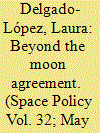

|
|
|
|
|
| Summary/Abstract |
The 1979 Moon Agreement was conceived as a way to help manage one of the expected outcomes of expanded activities on the Moon: exploitation of its natural resources. However, the fifth of the international space treaties elaborated in the early stages of the Space Age failed to receive widespread acceptance. Persisting polarization about key provisions in the Agreement hampers its success in the near future. This article examines the legacy of the Moon Agreement from a policy perspective by identifying key principles that are poised to resurface in the near future with the advent of new actors in space, especially the private sector. It argues that the development of norms of behavior together with national regulation and legislation represent the most promising way to engage established and emerging space actors in ensuring responsible behavior beyond Earth orbit.
|
|
|
|
|
|
|
|
|
|
|
|
|
|
|
|
| 2 |
ID:
142557


|
|
|
|
|
| Summary/Abstract |
Telesat Canada is a satellite communications firm, founded in 1969, that provides global broadcast and broadband services. Its fleet of satellites includes the geostationary Anik line. On January 20, 1994, a major solar storm knocked out communications on two Anik satellites. Anik E1 was recovered through a backup system within hours. However, Anik E2 was non-operational until June 1994, when engineers used an innovative ground fix to regain control.
|
|
|
|
|
|
|
|
|
|
|
|
|
|
|
|
| 3 |
ID:
142560
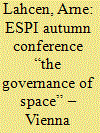

|
|
|
|
|
| Summary/Abstract |
The concept of governance has gained considerable attention over the last years. This is true for all parts of society, but very pronouncedly for space, where the increasing diversity of players is calling for ever better approaches to deal with the establishment and monitoring of policies and the management of humanity's most expansive global common. In this process, reference is almost always made to the term governance. In many cases, it is understood in rather specific technical and legal contexts, but it is also used very broadly and sometimes quite indiscriminately. In order to shed light on many of the hidden underlying dynamics of governance, the European Space Policy Institute (ESPI) addressed the topic at its 8th Autumn Conference on 11–12 September 2014. To capture the topic of governance from a wide variety of angles, speakers included representatives from space agencies, industry and academia – coming from different parts of the world. Main topics which were addressed during the conference included the relationship between space governance and international relations theory, the effects of liberalisation, regionalisation and geopolitics on space governance, and the evolution of space governance in the European context. This brief report captures the major findings of the two-day event and accentuates a number of trends recurring throughout the speakers' presentations.
|
|
|
|
|
|
|
|
|
|
|
|
|
|
|
|
| 4 |
ID:
142554
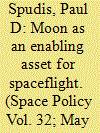

|
|
|
| 5 |
ID:
142559


|
|
|
|
|
| Summary/Abstract |
From the Heads of State of the G8 nations, the European Union, international organisations, through to national laws and policies, there is a strong momentum for full, free and open access to public sector digital data so that the benefits of public investment in such data can be maximised with as few barriers to use as possible. While open data for society at large is a relatively new phenomenon, the space sector has been accustomed to open data for all of its existence, especially in astronomy and navigation, but also in Earth observation. In the context of the open data debate, the purpose of this paper is to examine 21 policy and legal instruments concerning open data made by a range of organisations that in one way or another relate to Earth observation data and therefore contribute to the critical examination of the effectiveness of the open data movement. Based on these documents, the paper discusses common issues such as changing perspectives on the desirability of open data, commercial use, and licences and exceptions, and concludes that open access to Earth observation data requires more specification in order to clarify the conditions of access and so to realise fully the potential benefits.
|
|
|
|
|
|
|
|
|
|
|
|
|
|
|
|
| 6 |
ID:
142556
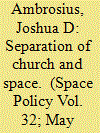

|
|
|
|
|
| Summary/Abstract |
Despite growing interest in the relationship between religion and outer space, the influence of religion on space policy attitudes remains a mostly unexplored topic. This study fills this research gap by treating space exploration as a policy issue for examination by religion and politics theory. It uses data from the General Social Survey and three Pew surveys to construct several logistic regression models. Space policy support, the dependent variable, is operationalized in seven ways as the antecedents of policy views (i.e., space knowledge and interest), actual policy/funding views, and policy expectations. Religion, the key independent variable, is operationalized as belonging (tradition), behavior (church attendance), beliefs, and salience. In addition, one survey permits the identification of the nature of science messages espoused by clergy. The findings reveal that Evangelical Protestants in the U.S. are the least supportive of space policy. However, evidence shows that pro-science messages from the pulpit can change Evangelicals' perceptions of space exploration. The article concludes with calls for increased, concerted outreach to Evangelicals and other religious publics by the space community. These efforts are essential if the American republic will pursue greater space exploration in the near future. Ultimately, religions must ensure their survival by embracing space.
|
|
|
|
|
|
|
|
|
|
|
|
|
|
|
|
| 7 |
ID:
142558
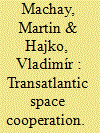

|
|
|
|
|
| Summary/Abstract |
After the Cold War ended in the disintegration of the Soviet Union, the space race was not the factor behind the space exploration and exploitation anymore. The aim of this paper is to analyze the transatlantic space cooperation between the USA (more specifically NASA) and the ESA. The cooperation can be driven by two major motives – economic and political. The empirical evidence suggests that while ESA is motivated by the economic one NASA is motivated by the political one. ESA is seemingly on NASA's tail but it benefits economically.
|
|
|
|
|
|
|
|
|
|
|
|
|
|
|
|
| 8 |
ID:
142555
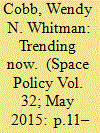

|
|
|
|
|
| Summary/Abstract |
This article addresses a timely and widespread issue, that of public opinion and the rise of “big data.” Analysts of US space policy have consistently noted the role that public opinion plays in setting the directions for US space exploration. However, the tools that have been used to measure public opinion suffer from serious shortcomings in terms of timing and lack of available data. This paper introduces two new measures of public opinion, Google Trends and Twitter, and details how they can be used to assist in measuring interest in space policy in the American public.
|
|
|
|
|
|
|
|
|
|
|
|
|
|
|
|
| 9 |
ID:
142552
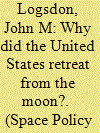

|
|
|
|
|
| Summary/Abstract |
On July 20, 1969, Neil Armstrong and Buzz Aldrin took the first human steps on a celestial body other than Earth. Just over two weeks later, on August 4, NASA presented to a committee charged with making recommendations on the U.S. post-Apollo space program a bold plan of continued lunar and Martian exploration. Over the next six months, that plan was decisively rejected by the administration of President Richard M. Nixon. In 1970, NASA canceled the final two Apollo missions to the Moon, and on January 5, 1972, President Nixon announced approval of the space shuttle program. Focusing the U.S. space program on operating the space shuttle and building a space station has kept the United States human space flight program confined to low Earth orbit for over four decades. There are lessons to be learned from the post-Apollo decisions in the United States for today's attempts to gain political support for a renewed and sustainable program of human exploration of the Moon, Mars, and other solar system destinations. This paper, drawing on in-depth research on the events of the 1969–1972 period in U.S. space policy, will discuss those lessons.
|
|
|
|
|
|
|
|
|
|
|
|
|
|
|
|
|
|
|
|
|